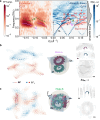Terahertz-field activation of polar skyrons
- PMID: 41068083
- PMCID: PMC12511383
- DOI: 10.1038/s41467-025-64033-6
Terahertz-field activation of polar skyrons
Abstract
Unraveling collective modes arising from coupled degrees of freedom is crucial for understanding complex interactions in solids and developing new functionalities. Unique collective behaviors emerge when two degrees of freedom, ordered on distinct length scales, interact. Polar skyrmions, three-dimensional electric polarization textures in ferroelectric superlattices, disrupt the lattice continuity at the nanometer scale with nontrivial topology, leading to previously unexplored collective modes. Here, using terahertz-field excitation and femtosecond x-ray diffraction, we discover subterahertz collective modes, dubbed "skyrons", which appear as swirling patterns of atomic displacements functioning as atomic-scale gearsets. The key to activating skyrons is the use of the THz field that couples primarily to skyrmion domain walls. Momentum-resolved time-domain measurements of diffuse scattering reveal an avoided crossing in the dispersion relation of skyrons. Atomistic simulations and dynamical phase-field modeling provide microscopic insights into the three-dimensional crystallographic and polarization dynamics. The amplitude and dispersion of skyrons are demonstrated to be controlled by sample temperature and electric-field bias. The discovery of skyrons and their coupling with terahertz fields opens avenues for ultrafast control of topological polar structures.
© 2025. The Author(s).
Conflict of interest statement
Competing interests: The authors declare no competing interests.
Figures




References
-
- Girvin, S. M. & Yang, K. Modern Condensed Matter Physics (Cambridge University Press, 2019).
-
- Balents, L., Dean, C. R., Efetov, D. K. & Young, A. F. Superconductivity and strong correlations in moiré flat bands. Nat. Phys.16, 725–733 (2020).
-
- He, F. et al. Moiré patterns in 2d materials: a review. ACS Nano15, 5944–5958 (2021). - PubMed
-
- Adak, P. C., Sinha, S., Agarwal, A. & Deshmukh, M. M. Tunable moiré materials for probing Berry physics and topology. Nat. Rev. Mater.9, 481–498 (2024).
-
- Ramesh, R. & Schlom, D. G. Creating emergent phenomena in oxide superlattices. Nat. Rev. Mater.4, 257–268 (2019).
Grants and funding
LinkOut - more resources
Full Text Sources

